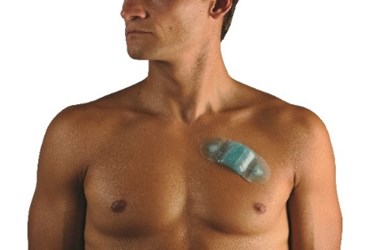Patch Outperforms Holter For Prolonged Heart Rhythm Tracking

Scripps study suggests shift in decades-old practice for detecting irregular heart beats
Research by the Scripps Translational Science Institute (STSI) has found that a small adhesive wireless device worn on the chest for up to two weeks does a better job detecting abnormal and potentially dangerous heart rhythms than the Holter monitor, which is typically used for 24 hours and has been the standard of care for more than 50 years.
The findings, which were published and made publically available online by the American Journal of Medicine today, suggest that the ZIO Service — which includes the ZIO Patch, data analysis and a diagnostic report provided by device maker iRhythm Technologies of San Francisco — could replace the Holter monitor as the preferred method of tracking electrical heart activity in ambulatory patients.
“This is the first large prospective validation that this new technology superseded the device invented by Norman Holter in 1949,” said study senior author Eric Topol, MD, a cardiologist who directs STSI and serves as the chief academic officer of Scripps Health. “By tracking every heart beat for up to two weeks, the ZIO Service proved to be significantly more sensitive than the standard Holter, which uses multiple wires and typically is only used or tolerated for 24 hours.
“For millions of people who present each year with suspected arrhythmia, this may prove to be the new standard for capturing the culprit heart rhythm electrical disturbance, most commonly atrial fibrillation which carries a significant risk of stroke,” he said.
Patch worn during normal activity
The ZIO Patch is a Food and Drug Administration-cleared compact, low-profile, noninvasive, water-resistant device that is worn for up to two weeks throughout normal activity then mailed by the patient to iRhythm for data analysis with a proprietary algorithm. The Holter monitor, which was first introduced in the 1940s, includes a cell-phone sized recorder typically worn at the waist and five to seven lead wires that attach to the chest.
The STSI study used electrocardiograph data collected from 146 patients who were fitted with a ZIO Patch and a Holter monitor after being referred to the cardiac investigations laboratory at Scripps Green Hospital for ambulatory heart monitoring. The Holter monitor was worn for 24 hours, and the ZIO Patch was worn for up to 14 days.
Over the course of the study, the ZIO Service detected 96 arrhythmia events while the Holter monitor detected 61. The researchers credited the patch’s superior performance primarily to prolonged monitoring.
Patients prefer ZIO
Physicians who reviewed data from both devices reported reaching a definitive diagnosis 90 percent of the time when using the patch results and 64 percent of the time when using Holter monitor data. A survey of study participants found that 81 percent of them preferred wearing the patch over the Holter monitor, with 76 percent saying the Holter monitor affected their daily living activities.
One unexpected finding was that the Holter monitor detected 11 more arrhythmias than the ZIO Service during the initial 24 hour period when both devices were working simultaneously. However, all of those arrhythmias were picked beyond 24 hours by the patch during the device’s extended monitoring period. The ZIO Service detected two arrhythmias not captured by the Holter during the initial 24 hour period.
Other study co-authors were Paddy Barrett, M.D.; Ravi Komatireddy, M.D.; Sharon Haaser; Sarah Topol; Judy Sheard; Senyase Encinas; and Angela J. Fought.
Funding for the research project was provided by iRhythm Technologies and through a National Institutes of Health Clinical and Translational Science Award made to STSI.
STSI is a NIH-sponsored consortium led by Scripps Health in collaboration with The Scripps Research Institute. Through this innovative partnership, Scripps is leading the effort to translate the latest wireless and genetic medical technologies into high-quality, cost-effective treatments for patients.
Source: The Scripps Translational Science Institute (STSI)
